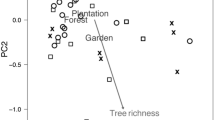Abstract
We measured the repellent effects of plant resins against the weaver ants, Oecophylla smaragdina. The resins were the sticky bands of the dwarf honeybees, Apis florea and A. andreniformis, propolis of the Western honeybee, A. mellifera and the nest entrance tubes of the stingless bees, Tetrigona apicalis, Lepidotrigona terminata, and Tetragonula collina. A bioassay was developed for testing the effects of these resins in field experiments by placing them along natural foraging pathways of ants’ nests. A repellency index was generated to quantify this bioactivity. The sticky bands of dwarf honeybees and propolis of A. mellifera were significantly more repellent against O. smaragdina than were the entrance tube resins of the stingless bees. Nonetheless, the diverse, viscid and adhesive resins employed by these bees constitute a generally effective first-line of defense against depredations of a formidable adversary, the weaver ants.







Similar content being viewed by others
References
Betz O. and Kolsch G. 2004. The role of adhesion in prey capture and predator defense in arthropods. Arthropod Struct. Dev. 33: 3-30
Burdock G.A. 1998. Review of the biological properties and toxicity of bee propolis (propolis). Food Chem. Toxicol. 36: 347-363
Duangphakdee O., Koeniger N., Koeniger G., Wongsiri S. and Deowanish S. 2005. Reinforcing a barrier—a specific social defense of the dwarf honeybee (Apis florea) released by the weaver ant (Oecophylla smaragdina). Apidologie 36: 505-511
Debboun M., Frances S.P. and Strickman D. 2006. Insect Repellents: Principles, Methods, and Uses. CRC Press 495 pp
Eisner T. 2003. For Love of Insects. Harvard University Press, Cambridge, MA. 448 pp
Evans D.L. and Schmidt J.O. (Eds). 1990. Insect Defenses: Adaptive Mechanisms and Strategies of Prey and Predators. State University of New York Press, Albany, NY. 482 pp
Ghisalberti E.L. 1978. Propolis: a review. Bee World 60: 59-84
Hermann H.R. and Blum M.S. 1981. Defense mechanisms in the social Hymenoptera. In: Social Insects (Hermann H.R., Ed). Academic Press, NY. pp 77-197
Hölldobler B. and Wilson E.O. 1978. The multiple recruitment system of the African weaver ant Oecophylla longinoda (Latreille) (Hymenoptera: Formicidae). Behav. Ecol. Sociobiol. 3: 19-60
Hölldobler B. and Wilson E.O. 1990. The Ants. Harvard University Press, Cambridge, MA. 732 pp.
Howard J.J. 1985. Observations on resin collecting by six interacting species of stingless bees (Apidae: Meliponinae). J. Kans. Ent. Soc. 58: 337-345
Khoo S.G. and Yong H.S. 1987. Nest structure and colony defense in the stingless bee Trigona terminata Smith. Nature Malaysiana 12: 4-15
Leonhardt S.D., Blüthgen N. and Schmitt T. 2009. Smelling like resin: terpenoids account for species-specific cuticular profiles in Southeast-Asian stingless bees. Insect. Soc. 56 (in press)
Maidl F. 1934. Die Lebensgewohnheiten und Instinkte der staatenbildenden Insekten, Fritz Wagner, Wien. 823 pp
Marcucci M.C. 1995. Propolis: chemical composition, biological properties and therapeutic activity. Apidologie 26: 83-99
Michener C.D. 1974. The Social Behavior of the Bees: A Comparative Study. Harvard University Press, Cambridge, MA. 404 pp
Michener C.D. 2007. The Bees of the World, 2nd Ed. John Hopkins University Press, Baltimore. 953 pp
Morse R.A. and Flottum K. (Eds). 1997. Honeybees Pests, Predators and Diseases, 3 rd Ed. A.I. Root Co., Medina, OH. 718 pp
Nakamura J. and Seeley T.D. 2006. The functional organization of resin work in honeybee colonies. Behav. Ecol. Sociobiol. 60: 339-349
Oldroyd B.P. and Wongsiri S. 2006. Asian Honeybees: Biology, Conservation and Human Interactions. Harvard University Press, Cambridge, MA. 340 pp
Popova M., Silici S., Kaftanoglu O. and Bankova V. 2005. Antibacterial activity of Turkish propolis and its qualitative and quantitative chemical composition. Phytomedicine 12: 221-8
Punchihewa R.W.K. 1994. Beekeeping for Honey Production in Sri Lanka: Management of Asiatic Hive Honeybee Apis cerana in its Natural Tropical Monsoonal Environment. Sri Lanka Department of Agriculture, Peradeniya Sri Lanka and Canadian International Development Agency, Quebec, Canada. 232 pp
Rasmussen C. 2008. Catalog of the Indo-Malayan/Australasian stingless bees (Hymenoptera: Apidae: Meliponini). Zootaxa. 1935: 1-80.
Roubik D.W. 1989. Ecology and Natural History of Tropical Bees. Cambridge University Press, NY. 514 pp
Roubik D.W. 2006. Stingless bee nesting biology. Apidologie 37: 124-143
Sakagami S.F. 1982. Stingless bees. In: Social Insects (Hermann H.R., Ed). Academic Press, NY. pp 361-432
Sakagami S.F, Inoue T., Yamane S. and Salmah S. 1983. Stingless bees. In: Ecological Study on Social Insects in Central Sumatra with Special Reference to Wasps and Bees (Ohgushi R., Ed). Sumatra Nature Study (Entomology), Kanazawa University, Kanazawa, Japan. pp 37-56
Seeley T.D. 1983. The ecology of temperate and tropical honeybee societies. Am. Sci. 71: 264-272
Seeley T.D. 1985. Honeybee Ecology: A Study of Adaptation in Social Life. Princeton University Press. NJ. 201 pp
Seeley T.D., Seeley R.H. and Akratanakul P. 1982. Colony defense strategies of the honeybees in Thailand. Ecol. Monogr. 52: 43-63
Wongsiri S., Lekprayoon C., Thapa R., Thirakupt K., Rinderer T.E., Sylvester H.A., Oldroyd B.P. and Booncham U. 1996. Comparative biology of Apis andreniformis and Apis florea in Thailand. Bee World 77: 23-35
Acknowledgments
Our thanks to Dr. Gudrun Koeniger for her kind support; Prof. Dr. Ulrich Maschwitz for valuable advice; Prof. Chariya Lekprayoon for providing facilities at Chulalongkorn University; Dr. Mananya Phiancharoen for her kind help. The Thailand Research Fund is acknowledged for financial support through the Royal Golden Jubilee Project. Colleen Hepburn kindly reviewed the manuscript.
Author information
Authors and Affiliations
Corresponding author
Rights and permissions
About this article
Cite this article
Duangphakdee, O., Koeniger, N., Deowanish, S. et al. Ant repellent resins of honeybees and stingless bees. Insect. Soc. 56, 333–339 (2009). https://doi.org/10.1007/s00040-009-0027-z
Received:
Revised:
Accepted:
Published:
Issue Date:
DOI: https://doi.org/10.1007/s00040-009-0027-z




